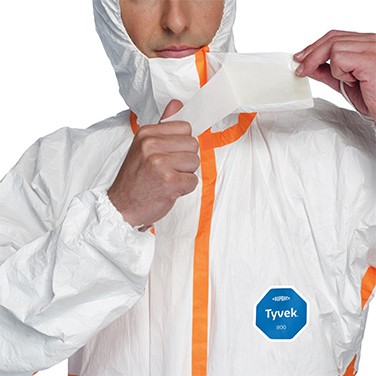The Science and Safety Behind the White Suits
By Dr. Alex Bradley, Principal Investigator, DuPont Personal Protection
Providing a safer work environment through education, awareness, and training is a critical process. But it can be challenging to navigate the broad landscape of industry standards, complex regulations, chemical cleaning, and biological safety requirements. And selecting the right personal protective equipment (PPE) can be difficult because of the wide variety of coverall, sleeve, shoe cover, and other apparel options. Fortunately, however, industry advances in communication technologies, analytical capabilities, and material science continue to improve the PPE available for workplace health and safety.
Hazards Risk Assessments
A hazard risk assessment is an essential element of any safety program, and you should complete one before you begin working. The assessment will help you identify and evaluate any hazards associated with your planned activities. Here are some questions to include:
- How exposed is the worker?
- How much of the hazard will the worker be exposed to?
- How concentrated or intense is the hazard?
- How long will exposure last?
- How frequently will exposure occur?
After completing the assessment, you can determine and implement exposure controls. The Occupational Safety and Health Administration (OSHA) identifies this hierarchy of exposure control, with PPE serving as the last line of defense:
- Substitution: Can you reduce or eliminate the hazard?
- Engineering: Are there technical solutions to make the job safer?
- Work Practices: Are the proper tools and procedures in place?
- PPE: Does the worker need to also use personal protective equipment?
Garment Selection Criteria
You should consider three essential elements when evaluating garments for protection against your specific risks and hazards: fabric, seam, and design. Fabric selection criteria includes:
- Protection: Will potentially hazardous materials penetrate the garment? Does the product comply with industry and/or government requirements?
- Durability: Will the item maintain its protection throughout the task? Will the worker need to change or replace the item during the task?
- Comfort: Will the garment contribute to heat stress? Will wearing the garment reduce worker productivity?
Seams help provide strength, durability, and hazard protection. However, seams may also be a weak barrier on the garment. There are five main types of seam construction:
- Serged (Sewn): Threads join and overlock the edges of two pieces of fabric
- Bound: An extra piece of fabric is sewn over the edges of the fabric to increase seam strength and improve the barrier
- Welded: Two pieces of material are ultrasonically or thermally fused
- Taped: A strip of compatible material is affixed to the sewn seam to add strength and protect against heavy liquid splash
- Double Taped: A strip of compatible material is affixed to both the inside and outside of a sewn seam
Design features will depend on end-user needs. The hazard risk assessment will help you determine the style and accessories needed for appropriate PPE, including coveralls, lab coats, hoods, sleeves, or shoe covers.
Tyvek Protective Apparel
All white suits may look the same, but DuPont Tyvek makes a difference where it’s needed most: on the job. Tyvek offers unmatched protection, improved breathability, and better garment durability. It’s lighter than spunbonded-meltblown-spunbonded (SMS) and microporous film (MPF), and its durability delivers a consistently better barrier, even with wear and abrasion.
Choose from a complete line of clean-processed and sterile single-use clothing designed to support your controlled environment gowning needs. Tyvek IsoClean provides a barrier against dry particles, microorganisms, and nonhazardous liquids. Tyvek Micro-Clean 2-1-2 delivers the particle barrier, durability, and comfort of Tyvek in a unique blue color. Blue and white coverall color options let you distinguish workers by task within multipurpose facilities, designate workers allowed in restricted areas, or more easily identify team leaders or supervisors.
ProShield 80 Coveralls
DuPont ProShield 80 coveralls are designed for conditions that require protection from contact with blood and bloodborne pathogens, including clinical laboratory testing, animal science, emergency response, and biohazard remediation.
Industry standards such as OSHA 1910.1030 for occupational exposure to blood or other potentially infectious materials can help you determine the appropriate PPE. Other PPE guidelines can be found in the manual Biosafety in Microbiological and Biomedical Laboratories (BMBL, HHS Publication No. (CDC) 21-1112).
Find Products and Information with SafeSPEC
DuPont SafeSPEC is a free, digital, customer-focused product selection tool. Based on data from thousands of permeation tests with Tychem and other DuPont fabrics, SafeSPEC lets users search by hazard, industry, brand/fabric, design, seam, and certifications. SafeSPEC also serves as a source for literature and videos, technical information, frequently asked questions, and other information about garments and accessories. Find SafeSPEC at safespec.dupont.com or add the app to your tablet or smartphone.

Content provided by:



